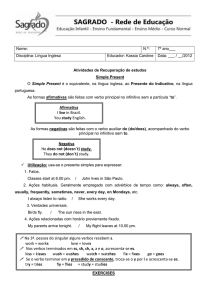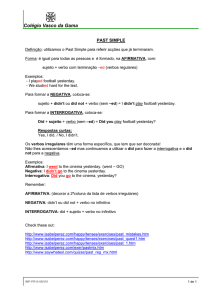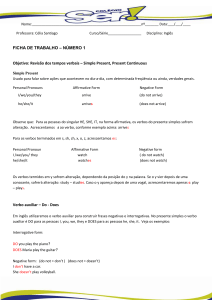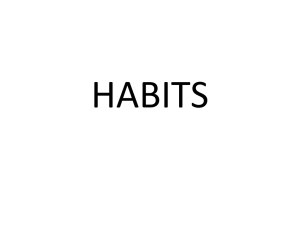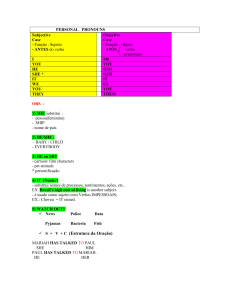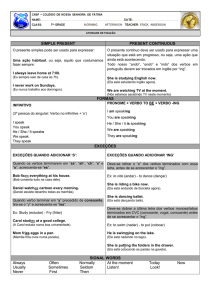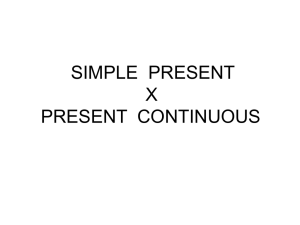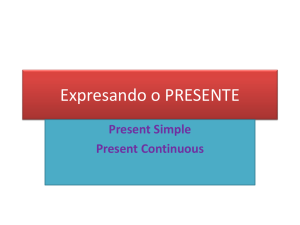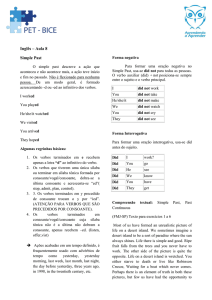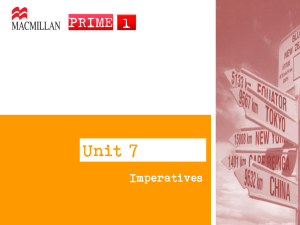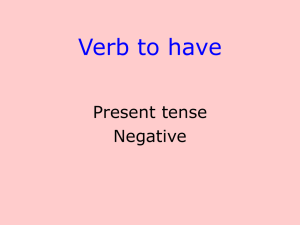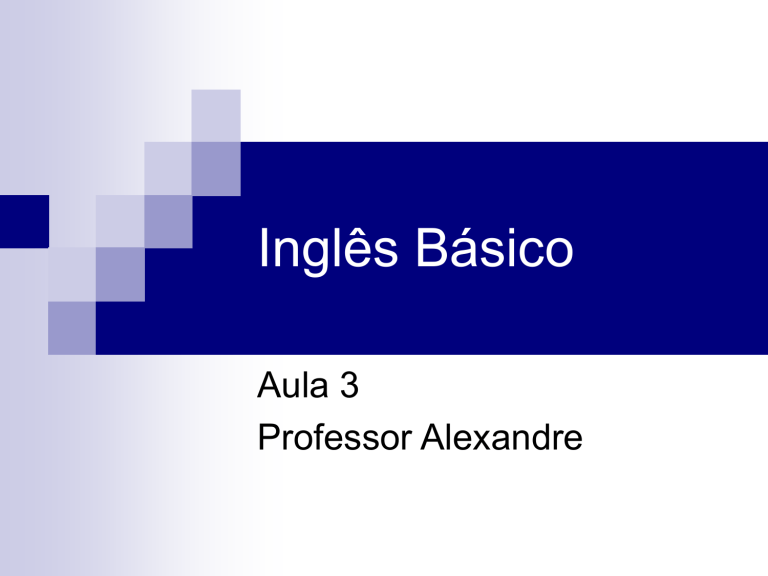
Inglês Básico
Aula 3
Professor Alexandre
The simple present tense
Forma-se este tempo verbal retirando-se o to do infinitivo.
Acrescentamos “S” ou “ES” às terceiras pessoas do singular.
É usado para expressar:
uma verdade geral; uma declaração em geral; uma ação habitual ou
um programa futuro.
Exemplos:
Water boils at 100º C.
Kids like sweets.
She always studies hard.
They arrive here next Wednesday.
1. Regras para acréscimo de “ES/IES”:
Acrescenta-se “ES” a verbos terminados em
S/SH/CH/O/Z/X:
Quando o verbo terminar em “Y” precedido de
consoante, retira-se o “Y” e acrescenta-se “IES”.
He watches TV every day.
She goes to school every morning.
That machine fixes old cars.
He always carries his things home with him. To carry
She studies math every day. To study
Nota: A terceira pessoa do singular do verbo HAVE é HAS.
2. Formas interrogativa e negativa:
Question Form:
Do/Does + sujeito + verbo principal no
infinitivo sem “to”:
Exemplos:
Do you study in the afternoon?
Does the teacher speak French?
Negative Form:
sujeito + do/does + not + verbo principal no
infinitivo sem “to”:
Exemplos:
do not study in the afternoon.
I don´t study in the afternoon.
The teacher does not speak French.
The teacher doesn’t speak French.
I
Real life example:
The simple past tense
Corresponde à segunda forma principal do
verbo.
Expressa uma ação que ocorreu em um ponto
de tempo definido no passado.
Exemplos:
We
sent them the reports last night.
We needed to see him yesterday.
When he called her, she came running to meet him.
1. Regras para acréscimo de “ED/IED”
em verbos regulares:
Acrescentamos “D” aos verbos terminados em “E”;
Exemplo: RECEIVE We received the pack last week.
Verbos terminados em “Y” e precedido de consoante:
perdem o “Y” para o “I”;
Exemplo: STUDY He studied all his lessons yesterday.
Verbos terminados em “Y” precedido de vogal:
acrescenta-se “ED”;
Exemplo: PLAY The kids played a lot yesterday.
1. Regras para acréscimo de “ED/IED”
em verbos regulares:
Se o verbo for constituído apenas por uma
sílaba e terminar em consoante + vogal +
consoante, dobramos a consoante final;
Exemplo: STOP He stopped at the traffic light.
Se o verbo tiver duas sílabas, sendo a última
tônica, e terminar em consoante + vogal +
consoante, dobramos a consoante final.
Exemplo: PREFER We preferred to stay home
last weekend.
2. Formas interrogativa e negativa:
Question Form: Did + sujeito + verbo principal no
infinitivo sem “to”:
Exemplos: Did she see them last week?
Did Mark do his exercises?
Negative Form: sujeito + did + not + verbo principal no
infinitivo sem “to”:
Exemplos: She did not see them last week.
She didn´t see them last week.
Mark did not do his exercises.
Mark didn´t do his exercises.
The simple future tense
É usado para expressar uma ação futura.
Existem as seguintes formas de
construção deste tempo:
Will
+ infinitivo sem to
Shall + infinitivo sem to
To be going + infinitive com to
A forma mais utilizada é a will. Esta expressa uma ação
futura cuja decisão de se executá-la é tomada no
momento da fala.
A forma be going to é utilizada para expressar uma
ação futura planejada ou para expressar uma ação que
tem grande possibilidade de ocorrer.
Exemplos:
They will meet them tomorrow morning.
We will be very glad to receive you.
We shall punish them if they don´t behave.
The sky is cloudy. I think it is going to rain.
Stop it. You are going to fall down!
The present continuous tense
Forma-se com o verbo be (present tense) +
verbo principal no infinitivo sem to, acrescido do
ING.
É usado para descrever uma ação que está
acontecendo no presente momento, ou para
descrever uma repetição constante de uma
ação.
Pode, também, indicar planos imediatos futuros.
Exemplos:
Peter is writing a letter now.
She is preparing a cake at this moment.
Look! They are running to the park.
My father is always smoking a lot.
What are you doing tonight?
Nota: Não usamos os seguintes verbos nos
tempos contínuos:
Relacionados com pensamentos: remember, forget,
understand, etc.
Relacionados com sensações: hear, see, taste, etc.
Relacionados com desejos: wish, need, desire, etc.
Relacionados com emoções: like, love, hate, etc.
Exemplos:
She understands it now.
I see better now with glasses on.
Exercícios
Oh, temptation
If only fast-food were truly
addictive
If only fast-food were truly addictive
Oh, temptation
If only fast-food were truly addictive
LAST week, Caesar Barber of New York filed class-action lawsuit
against McDonald's, Kentucky Fried Chicken, Burger King and Wendy's,
four of the world's biggest fast-food chains. His claim was that they were
responsible for his obesity and poor health. According to his lawyer, fastfood had created a "craving" in his hapless client, who was blissfully
unaware, until his doctor told him, that consuming huge piles of burgers,
fries and milkshakes was not actually good for his health.
Such an absurd lawsuit may have been inevitable as soon as the big
tobacco settlements began burning a hole in trial lawyers' pockets. But
there is a catch: fast-food is not addictive. It does not, as a matter of fact,
create a real physical craving, because it contains no substance that
could induce one.
The Economist suggests that this should now change. Consider the
plight of the poor plaintiffs. They must prove that they were
physiologically compelled to consume fast-food, against the weight of
scientific evidence and the dictates of common sense. Then there are
the millions more who indulge in the stuff, but who would feel much
better about themselves if they knew they had been suborned into doing
so. Through the simple introduction of minute amounts of cocaine or
nicotine into their wares, fast-food companies could improve the lot of
such folk in future. (The Economist)
The passage tells that:
Caesar Barber is suing famous fast-food chains.
Caesar Barber knew that consuming burgers, fries and milkshakes
was not really good for his health.
Caesar Barber’s lawyer stated that fast-food is not addictive.
In the future big tobacco companies will be obliged to pay big
amounts of money for trial lawyers.
Fast-food creates a strong and uncontrollable physical desire,
leading to obesity and poor health.
In which of the following sentences the verb tense is not
correctly used?
The customer has filed a lawsuit against McDonald’s.
If he weren’t so fat, he could eat burgers and fries.
Hadn’t he eaten so many burgers, he wouldn’t get so fat.
He will feel much better if he knows the answer.
Tobacco settlements have increased in the United States lately.

